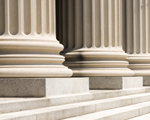Our company president, Kenric Van Wyk, was recently featured in a Wood TV 8 interview as an expert on noise levels. The local NBC affiliate was covering a story on a teenager who had been killed by a train after walking down the tracks while listing to an MP3 player through ear buds. We brought one of our noise meters down to the tracks and made measurements while a train went by, and the story made the evening news.
Earlier that day, before we headed out for the interview, Kenric mentioned to me that he had to be careful what he said on the news interview because Acoustics By Design could potentially be hired as an expert witness if the incident ends up in court. Ultimately, we could appear as an expert for either side of the case, plaintiff or defendant. There is potential for the railway or the family of the teenager to hire us to make measurements and present our expert opinions. And in fact, we are presently retained to offer expert witness testimony and evidence for several ongoing court cases across the Midwest. So, how can an acoustical expert witness enhance a court case?
It should be obvious that an acoustician can make scientific measurements of sound and produce factual evidence to support a case. More importantly, an acoustician’s credentials and independent status can prove to the jury that his or her opinion is unbiased and credible. But the most important addition an acoustician can make is to put flesh on the facts. Any engineer can spew numbers, but the seasoned expert witness acoustical engineer knows how to put the facts in layman’s terms and how to explain those facts in a way that connects with the human experience. Connecting with jurors means simplifying the complex and showing how the evidence relates to every day life. That’s the final element that pulls it all together, and without it, you cannot connect with a jury.
Kenric Van Wyk, PE, frequently offers expert witness on occupational hearing loss, workers’ compensation, environmental noise and law, product liability, land use, civil disputes, and accidental death and injury cases. He uses a wide variety of forensic acoustics and scientific techniques to gather evidence, including sound measurement, 3D acoustical modeling, and detailed noise and vibration analysis. This enables him to offer expert testimony and physical evidence that enhances the credibility of cases.
